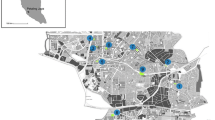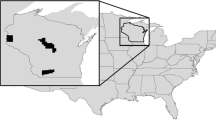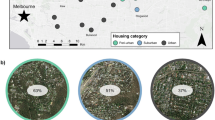Abstract
The present research focused on using spatial analysis to determine relationships among land ownership property sizes and landscape structure, with a focus on conservation management implications. Indices and metrics of ownership property sizes and landscape structure were calculated for 20 km buffer areas around 31 North American Breeding Bird Survey transects, 12 located within the Edwards Plateau ecoregion and 18 in contiguous ecoregions. The number of bird species observed at each transect provided a measure of avian species richness associated with land cover classes for each respective transect (González in Urban influence on diversity of avifauna in the Edwards Plateau of Texas: effect of property sizes on rural landscape structure, Texas A&M University, 2005). Spatial correlations were calculated between each pair of the landscape indices. Spatial analysis identified a “threshold of habitat fragmentation” for the 500 acre (ac) ownership property size. Significant spatial correlations among variables showed that property sizes lower than 500 ac produced habitat fragmentation represented by a decrease in mean patch size (MN) and proximity among habitat patches (Index PROX). Spatial analysis also made possible the prioritization of ecological sub-regions of the Edwards Plateau for conservation or restoration. The Live Oak-Mesquite Savannah showed the highest average ownership property size (7305 ac) and the highest values of patch richness. Based on the results, management in the Live Oak-Mesquite Savannah sub-region should focus on the conservation of land mosaic diversity to assure native avian species turnover (Whittaker 1972). In Balcones Canyon Lands, 64 % of land was covered by farms smaller than 500 ac and the overall average ownership property size was above the threshold of fragmentation (1440 ac), implying that management policies there should focus both on habitat conservation and on restoration. In contrast, 71 % of land in the Lampasas Cut Plains was covered by farms smaller than 500 ac, and average ownership property size was very close to the fragmentation threshold (625 ac). Consequently, the results indicate that management in the Lampasas Cut Plains sub-region should focus on habitat restoration (e.g., corridors that connect isolated habitat patches). In general, the threshold of ownership property size, 500 ac, is important for conservation planning because below that threshold of property size, habitat patch size begins to decrease and the distance between equivalent patches of habitat increases. Isolated patches act as islands within a sea of less suitable habitat which produce negative effects on biodiversity. Identifying the spatial characteristics indicative of habitat fragmentation, or the likelihood thereof, is an important issue for conservation planning in places with urban sprawl influence.






Similar content being viewed by others
References
Adger N, Luttrel C (2000) The values of wetlands: landscape and institutional perspectives. Property rights and the utilization of wetlands. Ecol Econ 35:75–89
Antrop M (2000) Changing patterns in the urbanized countryside of Western Europe. Landsc Ecol 15:713–730
Baldwin RF, Reed SE, McRae BH, Theobald DM, Sutherland RW (2012) Connectivity restoration in large landscapes: modeling landscape condition and ecological flows. Ecol Restor 30(4):274–279
Baudry J (1993) Landscape dynamics and farming systems: problems of relating patterns and predicting ecological changes. In: Bunce RGH, Ryszkowski L, Paoletti MG (eds) Landscape ecology and agro-ecosystems. Lewis Publishers, Boca Ratón, pp 21–40
Blair R (2004) The effects of urban sprawl on birds at multiple levels of biological organization. Ecol Soc 9(5):2
Brooks J, Stanfield J, Spies T (2002) Land ownership and landscape structure: a spatial analysis of sixty-six Oregon (USA) Coast Range watersheds. Landsc Ecol 17:685–697
Cardinale BJ, Duffy JE, Gonzalez A, Hooper DU, Perrings C, Venail P et al (2012) Biodiversity loss and its impact on humanity. Nature 486(7401):59–67
Clifford P, Richardson S, Hemmon D (1989) Assessing the significance of the correlation between two spatial processes. Biometrics 45(1):123–134
Collins OB, Smeins FE, Riskind DH (1975) Plant communities of the Blackland Prairie of Texas. In: Wali MK (ed) Prairie: a multiple view. University of North Dakota Press, Grand Forks, pp 75–87
Costanza R, Àrge R, de Groot R, Farber S, Grasso M, Hannon B, Limburg K, Naeem S, O’Neill R, Paruelo J, Raskin R, Sutton P, Marjan B (1997) The value of the world’s ecosystems services and natural capital. Nature 387:253–260
Dale MRT, Fortin MJ (2002) Spatial autocorrelation and statistical test in ecology. Ecoscience 9:162–167
Dodds-Weir C, Dykstra R (2003) Approaches to farmland preservation: an American case study. Farmland Preservation Research Project, Center for Land and Water Stewardship, University of Guelph, Guelph, p 58
Donovan T, Flather C (2002) Relationship among North American songbirds trends, habitat fragmentation, and landscape occupancy. Ecol Appl 12:364–374
Dutilleul P, Clifford P, Richardson S, Hemmon D (1993) Modifying the t-test for assessing the correlation between two spatial processes. Biometrics 49(1):305–314
Engle JA (2002) The relationship between ownership fragmentation and landscape structure in Bastrop County, Texas. Master’s Thesis, Department of Wildlife and Fisheries Sciences, Texas A&M University
Environmental Systems Research Institute (ESRI) (2000)
Feinberg DS, Hostetler ME, Reed SE, Pienaar EF, Pejchar L (2015) Evaluating management strategies to enhance biodiversity in conservation developments: perspectives from developers in Colorado, USA. Landsc Urban Plan 136:87–96
Felizola JA, Bini L, Hawkins B (2003) Spatial autocorrelation and red herrings in geographical Ecology. Glob Ecol Biogeogr 12:53–64
Fischer J, Lindenmayer DB (2007) Landscape modification and habitat fragmentation: a synthesis. Glob Ecol Biogeogr 16:265–280
Foley JA, DeFries R, Asner GP, Barford C, Bonan G, Carpenter SR et al (2005) Global consequences of land use. Science 309(5734):570–574
Fontana S, Sattler T, Bontadinac F, Moretti M (2011) How to manage the urban green to improve bird diversity and community structure Simone. Landsc Urban Plan 101:278–285
Forman R (1984) Landscape ecology. Wiley, New York
Fortin MJ, Gurevitch J (1993) Mantel tests: spatial structure in field experiments. In: Scheiner SM, Gurevitch J (eds) Design and ecological experiments. Chapman & Hall, New York, pp 343–359
Fortin MJ, Payette S (2002) How to test the significance of the relation between spatially autocorrelated data at the landscape scale: a case study using fire and forest maps. Ecoscience 9(2):213–218
Gavier-Pizarro GI, Radeloff VC, Stewart SI, Huebner CD, Keuler NS (2010) Rural housing is related to plant invasions in forests of southern Wisconsin, USA. Landsc Ecol 25:1505–1518
Gergel S, Turner M (2002) Learning landscape ecology: a practical guide to concepts and techniques. Springer, New York
Glennon MJ, Kretser HE (2013) Size of the ecological effect zone associated with exurban development in the Adirondack Park, NY. Landsc Urban Plan 112:10–17
González E (2005) Urban influence on diversity of avifauna in the Edwards Plateau of Texas: effect of property sizes on rural landscape structure. Doctoral dissertation, Texas A&M University
Gould FW (1975) The grasses of Texas. Texas A&M University Press, College Station
Grimm NB, Faeth SH, Golubiewski NE, Redman CL, Wu J, Bai X et al (2008) Global change and the ecology of cities. Science 319:756–760
Gutzwiller KJ, Flather CH (2011) Wetland features and landscape context predict the risk of wetland habitat loss. Ecol Appl 21(3):968–982
Hamilton CM, Martinuzzi S, Plantinga AJ, Radeloff VC, Lewis DJ, Thogmartin WE et al (2013) Current and future land use around a nationwide protected area network. PLoS One 8(1):e55737
Isaaks E, Srivastava M (1989) Applied geostatistics. Oxford University Press, New York
Kjelland M, Kreuter U, Clendenin G, Wilkins N, Wu B, Gonzalez E, Grant W (2007) Factors related to spatial patterns of rural land fragmentation in Texas. Environ Manag 40:231–244
Kowarik I (2011) Novel urban ecosystems, biodiversity, and conservation. Environ Pollut 159(8–9):1974–1983
Legendre P, Fortin MJ (1989) Spatial pattern and ecological analysis. Vegetatio 80:107–138
López R (2014) In the Texas land trends. Publication of the Texas A&M Institute of Renewable Natural Resources 1(1):1–6
Lovett-Doust J, Biernacki M, Page R, Chan M, Natgunarajah R, Timis G (2003) Effects of land ownership and landscape-level factors on rare-species richness in natural areas of southern Ontario, Canada. Landsc Ecol 18:621–633
Luck M, Wu J (2002) A gradient analysis of urban landscape pattern: a case study from the Phoenix metropolitan region, Arizona, USA. Landsc Ecol 17:327–339
Ludwig JA, Reynolds JF (1988) Statistical ecology: a primer on methods and computing. Wiley, New York
Martinuzzi S, Radeloff VC, Higgins JV, Helmers DP, Plantinga AJ, Lewis DJ (2013) Key areas for conserving United States’ biodiversity likely threatened by future land use change. Ecosphere 4(5):58
McGarigal K, Marks B (1995) FRAGSTATS: spatial pattern analysis program for quantifying landscape structure. Gen. Tech. Rep. PNW-GTR-351. United States Department of Agriculture, Forest Service. Pacific Northwest Research Station, Portland
McKinney ML (2002) Urbanization, biodiversity, and conservation. Bioscience 52:883–890
Mortberg U (2001) Resident bird species in urban forest remnants; landscape and habitat perspectives. Landsc Ecol 16(3):193–203
Musacchio LR (2011) The grand challenge to operationalize landscape sustainability and the design-in science paradigm. Landsc Ecol 26:1–5
National Land Cover Dataset (1992) United States Department of the Interior. http://www.mrlc.gov/nlcd1992.php. Accessed 3 Oct 15
National Resources Conservation Service (NRIS) (2013) 2007 National resources inventory—land use status and trends
NatureServe (2009) International ecological classification standard: terrestrial ecological classifications. NatureServe Central Databases, Arlington
Naveh Z (2007) Landscape ecology and sustainability. Landsc Ecol 22:1437–1440
Noss RF, Beier P, Covington WW, Grumbine RE, Lindenmayer DB, Prather JW, Schmiegelow F, Sisk TD, Vosick DJ (2006) Recommendations for integrating restoration ecology and conservation biology in Pondersa pine forests in the Southwestern United States. Restor Ecol 14:4–10
Radeloff VC, Hammer RG, Voss PR, Hagen AE, Field DR, Mladenoff DJ (2001) Human demographic trends and landscape level forest management in the northwest Wisconsin pine barrens. For Sci 47:229–241
Radeloff VC, Hammer RB, Stewart SI (2005a) Rural and suburban sprawl in the US Midwest from 1940 to 2000 and its relation to forest fragmentation. Conserv Biol 19(3):793–805
Radeloff VC, Hammer RB, Stewart SI, Fried JS, Holcomb SS, McKeefry JF (2005b) The wildland–urban interface in the United States. Ecol Appl 15(3):799–805
Radeloff VC, Williams JW, Bateman BL, Burke KD, Carter SK, Childress ES, Cromwell KJ, Gratton C, Hasley AO, Kraemer BM, Latzka AW, Marin-Spiotta E, Meine CD, Munoz SE, Neeson TM, Pidgeon AM, Rissman AR, Rivera RJ, Szymanski LM, Usinowicz J (2015) The rise of novelty in ecosystems. Ecol Appl 25(8):2051–2068
Rasker R, Hansen AJ (2000) Natural amenities and populations growth in the Greater Yellowstone region. Hum Ecol Rev 7(2):30–40
Reed SE, Kretser HE, Glennon MJ, Pejchar L, Merenlender AM (2012) Faunal biodiversity at the urban–rural interface: current knowledge, research priorities, and planning strategies. In: Lockaby BG, Zipperer W, Laband DN (eds) Urban-rural interfaces: linking people and nature. American Society of Agronomy, Madison, pp 99–114
Rosenberg MS, Anderson CD (2011) PASSaGE: pattern analysis, spatial statistics and geographic exegesis. version 2. Methods Ecol Evol 2(3):229–232.
Sauer JR, Hines JE, Fallon J (2003) The North American Breeding Bird Survey, results and analysis 1966–2002. Version 2003:1
Shackelford J, Shackelford C (2003) Fragments of a Texas landscape. Texas partners in flight–flyway newsletter. Texas Parks Wildl 10:16–18
Shochat E, Lerman S, Anderies J, Warren P, Faeth S, Nilon C (2010) Invasion, competition, and biodiversity loss in urban ecosystems. Bioscience 60(3):199–208
Smeins FE, Diamond DD (1983) Remnant grasslands of the Fayette Prairie, Texas. Am Midl Nat 110:1–13
Smith ZP, Glennon M, Karasin L, Reed S, Kretser H (eds) (2012) Protecting wildlife connectivity through land use planning: best management practices and the role of conservation development. Wildlife Conservation Society, Adirondack Program Technical Paper #4
Stanfield B, Bliss J, Spies T (2002) Land ownership and landscape structure: a spatial analysis of sixty-six Oregon (USA) Coast Range watersheds. Landsc Ecol 17:685–697
Stein BA (2002) States of the union: ranking America’s biodiversity. NatureServe, Arlington
Suarez-Rubio M, Leimgruber P, Renner SC (2011) Influence of exurban development on bird species richness and diversity. J Ornithol 152:461–471
Swenson J, Franklin J (2000) The effects of future urban development on habitat fragmentation in the Santa Monica Mountains. Landsc Ecol 15:713–730
Trousdale W, Gregory R (2004) Property evaluation and biodiversity conservation—decision support for making hard choices. Ecol Econ 48:279–291
Turner MG (1989) Landscape ecology: the effect of pattern on process. Annu Rev Ecol Syst 20:171–197
Turner MG, Gardner R, O’Neill R (2001) Landscape ecology in theory and practice: pattern and process. Springer, New York
U.S. Department of Agriculture (2000) Summary report: 1997 National Resources Inventory (revised December 2000). Natural Resources Conservation Service, Washington, DC, USA, and Statistical Laboratory, Iowa State University, Ames, IA, USA
U.S. Department of Agriculture (USDA) (1992) Census Bureau. http://www.nass.usda.gov/census/census92
Vitousek PM, Mooney HA, Lubchenko J, Melillo JM (1997) Human domination of earth’s ecosystems. Science 277(5325):494–499
Whittaker R (1972) Evolution and measurement of species diversity. Taxon 21:213–251
Wilkins N, Hays A, Kubenka D, Steinbach D, Grant W, González E, Kjelland M, Shakelford J (2003) Texas rural lands. Trends and conservation implications for the 21st century. Texas Cooperative Extension, Texas A&M University System, College Station
Wu J (2013) Landscape sustainability science: ecosystem services and human well-being in changing landscapes. Landsc Ecol 28(6):999–1023
Wu B, Smeins F, Slack D (2002) Fundamentals of ecology. Laboratory manual. Kendall/Hunt Publishing Company, Dubuque
Zonneveld IS, Forman RTT (eds) (1989) Changing landscapes: an ecological perspective. Springer, New York
Acknowledgments
We thank the Texas Cooperative Extension, the Texas A&M University System, Dr. Terri Morgan from Partnership for Environment (PFE) for partial economic support, and Dr. Maria Chakerian for her unconditional assistance with FRAGSTATS analysis.
Author information
Authors and Affiliations
Corresponding author
Rights and permissions
About this article
Cite this article
González Afanador, E., Kjelland, M.E., Wu, X.B. et al. Ownership property size, landscape structure, and spatial relationships in the Edwards Plateau of Texas (USA): landscape scale habitat management implications. Environ Syst Decis 36, 310–328 (2016). https://doi.org/10.1007/s10669-016-9604-7
Published:
Issue Date:
DOI: https://doi.org/10.1007/s10669-016-9604-7




